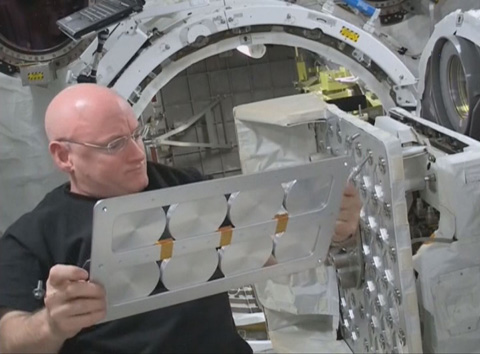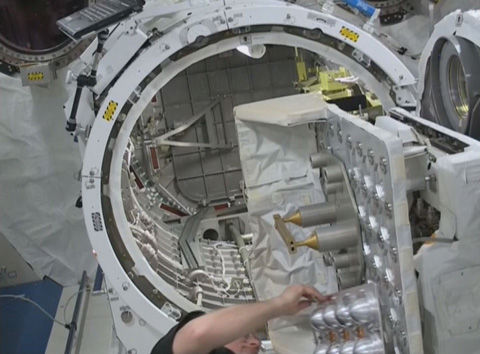.
The first Free-Space PADLES experiment intended to investigate the space radiation dose outside the Japanese Experiment Module “Kibo” was conducted from June 1-15, 2015.
PADLES will be shipped to the JAXA Tsukuba Space Center (TKSC) for analysis after its return to earth. During this technology demonstration mission, the following will be closely evaluated:
The space radiation environment in Low Earth Orbit (LEO)
The hull wall capability of Kibo as compared to its internal environment
The results of this experiment using PADLES will provide basic data useful for the risk assessment of Extravehicular Activities (EVA), and the assessment and optimization of hull wall thickness for manned spacecraft.
The next experiment is scheduled in March 2016 or later.
.

Astronaut Scott Kelly verifies the retrieved Free-Space PADLES (June 17, 2015) (Credit: JAXA/NASA)
.
Retraction to Kibo’s airlock
On June 15, under remote control from the TKSC, Kibo’s robotic arm with Free-Space PADLES attached to the Multi-Purpose Experiment Platform (MPEP) was transferred from the exposure point to in front of Kibo’s airlock door. PADLES on the MPEP was then retracted into the airlock.
.

MPEP being transferred to the airlock (June 15, Credit: JAXA/NASA)
.

The MPEP being transferred to the airlock on June 15 (Credit: JAXA/NASA)
.
Retrieval to the Kibo’s PM
The MPEP was retracted into the Kibo’s airlock. After depressurization to 1 atm, Astronaut Scott Kelly retrieved PADLES for its return to earth.
.

Retracted MPEP (Credit: JAXA/NASA)
.

Free-Space PADLES being removed from the MPEP (Credit: JAXA/NASA)
.
Various types of experiments using PADLES have been conducted since 2008 with the launch of Kibo modules.
Quelle: JAXA
3517 Views
